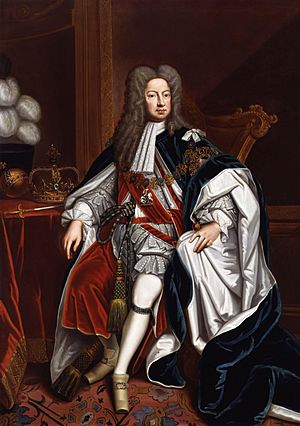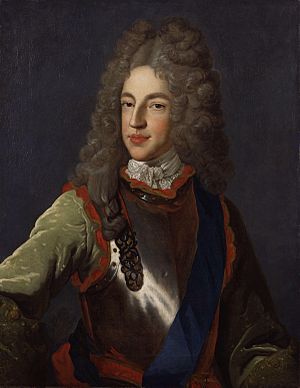1715 England riots facts for kids
In the spring and summer of 1715, many protests happened across England. Groups of people who strongly supported the Church of England attacked over forty meeting places belonging to English Dissenters. Dissenters were Protestants who were not part of the Church of England.
These protesters were also unhappy with the new king, King George I, and his government. King George was from the House of Hanover in Germany. His government was mostly made up of Whigs, a political group often linked to the Dissenters.
The protests took place on important dates. May 28 was King George I's birthday. May 29 was the day Charles II became king again after a period of no king. June 10 was the birthday of James Francis Edward Stuart, who many people believed should be the true king instead of George I.

Why the Riots Happened
When Queen Anne, the last queen from the House of Stuart, died in August 1714, Georg Ludwig, the Elector of Hanover, became King George I. This happened because of a law called the Act of Settlement 1701. This law said that Anne's half-brother, James Francis Edward Stuart, could not become king.
After King George arrived in Britain in September, he quickly removed the Tories from power. He then chose a government mostly made up of Whigs. When he was crowned king in October, there were already riots in over twenty towns.
The election in 1715 also saw many riots. It resulted in the Whigs winning most seats in Parliament. This meant the Tories were kept out of power. Some former Tory ministers were even accused of serious wrongdoing by the new government.
Some religious leaders from the Church of England also helped stir up trouble. They were known for encouraging large crowds. After King George became king, these leaders tried hard to help their party. They encouraged their church members to defend the Church of England. They also warned people about the dangers of the Whig government. A writer named Daniel Defoe complained that church pulpits were being used to encourage rebellion.
What Happened During the Riots
On March 8, the day Queen Anne became queen and King William III died, London saw protests. Bells rang, flags waved, and shops closed. On April 23, Queen Anne's coronation day, a crowd gathered at Snow Hill. They lit a bonfire under a banner showing Queen Anne. It had words praising her as "Just and Good." This might have hinted that she had promised to bring James Stuart back to the throne.
Near St Andrew's, Holborn, the crowd burned a picture of King William III. They also broke windows that were not lit up for the celebration. Some people suggested pulling down Dissenting meeting houses. This was similar to what happened during the 1710 Sacheverell riots. However, they were convinced not to do it.
The first major riots in London happened while Tory politicians were being accused of wrongdoing. On April 29, the birthday of a Tory leader, the Duke of Ormonde, was celebrated with noisy protests in Drury Lane and west London.
On King George I's birthday, May 28, large protests happened in Smithfield, Cheapside, and Highgate. The Dissenting chapel in Highgate was attacked. In Smithfield, a large crowd burned a dummy of Oliver Cromwell. In Cheapside, the rioters shouted, "No Hanoverian, No Presbyterian government!"
The next day, May 29, was Restoration Day. The crowd shouted, "A Restoration, a Stuart, High Church and Ormonde!" and "No King George, King James the third!" People who supported the Whigs had their windows broken. In Queen Street, a fight broke out between the rioters and the local citizen soldiers. At the London Stock Exchange, the crowd shouted, "High Church and the Duke of Ormonde!" People who dealt with money and shares were seen as bad by the rioters. One person who shouted, "Long live King George!" was beaten up.
In Oxford on May 28, a rumor spread that dummies of Queen Anne, Lord Bolingbroke, Ormonde, and Henry Sacheverell would be burned. In response, university students and townspeople attacked those celebrating King George's birthday. They broke into a Presbyterian meeting house. They made a bonfire of its pulpit, seats, and windows. They also burned a dummy of its minister. The crowd chanted, "An Ormond, an Ormond, a Bolingbroke, down with the Roundheads, no Hanover; a new Restoration!" The next day, a Quaker and Baptist meeting place was also attacked.
On June 10, Anglican churches in Clerkenwell and St Dunstan-in-the-West rang their bells to celebrate James Stuart's birthday. A Dissenting meeting place in Blackfriars was completely destroyed by the crowd. James's declaration was nailed to the door of a former Dissenting chapel in Lincoln's Inn Fields. This chapel had been destroyed five years earlier. Similar problems happened on James's birthday in Cambridge, Leeds, and several villages in Somersetshire. In Norton St Philip near Bath, James was publicly declared king. In Frome, the crowd was convinced not to destroy the local Dissenting chapel. In Marlborough, Wiltshire, the crowd broke into the church and rang the bells, even though the priest objected.
In the Midlands in late June and early August, similar riots against Dissenters took place. They started in Wolverhampton during St. Peter's fair and ended at Kingswinford in Worcestershire on August 1. One person urged the crowd, "Now boys go on we will have no King but James the third & he will be here in a month and we will drive the old Rogue into his Country again to sow Turnips." Similar words of loyalty to James were heard in Walsall and Leek.
In Warrington on June 10, bells were rung and the crowd shouted, "Down with the Rump!" However, they were stopped from attacking a Dissenting meeting house. In Leeds, a bonfire was made, and a man was later accused of threatening a Dissenting meeting place.
In Manchester in early May, James Stuart had been publicly declared James III. Between May 28 and June 23, there were many riots. The Dissenting chapel in Cross Street was robbed and destroyed between June 1 and July 30. One historian said this planned destruction sent a clear message to Dissenters. It showed that the Manchester crowd wanted them completely gone. It was a violent demand for everyone to follow the same religion, like in the time of Charles II. Soldiers eventually brought order, but the riots had spread. Dissenting chapels in Monton and Houghton were attacked on June 13. A week later, chapels in Blackley, Greenacres, Failsworth, and Standing were attacked. By June 25, chapels in Pilkington and Wigan had also been attacked.
In the West Midlands and Lancashire, over thirty Dissenting chapels were attacked.
One historian, Paul Monod, said that the strong anger towards Dissenters, especially Presbyterians, was surprising. He said that ordinary English people's anger focused on religious places, especially the hated meeting houses. He believes that ordinary English people loved the Church of England because it represented unity. They feared that King George and the Whigs would bring back the rule of the Puritans from 1649–1660, when the Church of England had been removed.
What Happened Next
About 500 people were arrested for rioting in Shropshire, Staffordshire, and Worcestershire. Around 2,000 people took part in the riots in these counties. Several hundred more were involved in Birmingham.
To stop these disturbances, the new Whig government passed the Riot Act. This law gave local officials more power. It allowed them to break up protests without fear of being punished.
In September and early October, the government arrested important Tories. They feared a rebellion by those who supported James Stuart. This rebellion, known as the Jacobite rising of 1715, eventually failed.
See also


